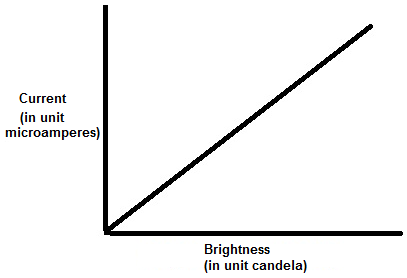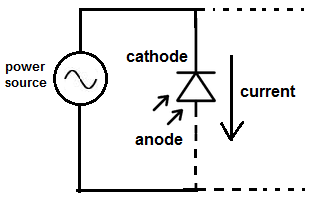What is a Photodiode?

A photodiode is a transducer that takes light energy and converts it into electrical energy.
If placed in a dark room, the photodiode is exposed to no light; therefore it creates no electricity. However, if light falls upon it, it takes the light energy and produces electric current in response.
A photodiode conducts electric current directly proportional to the amount of
light that falls upon it. It's a perfect direct relationship.
Graph of Photodiode Current Output Based on Intensity of Light

This graph shows this direct relationship between the brightness that a
photodiode is exposed to and the amount of current that it produces.
How to Connect a Photodiode to a Circuit
A photodiode operates in a circuit in reverse bias. This means that the anode connects to ground of the circuit and the cathode connects to the positive voltage supply of the circuit. Current flows from the cathode to the anode when exposed to sufficient light.
This is shown in the circuit below:

The majority of the times photodiodes are connected to a power source in a circuit. This is because photodiodes normally produce only microamperes of current, by themselves, which not enough power to drive most electronic devices. When coupled with a power source, more current can be delivered in the circuit. So normally a voltage source such as a battery is used in conjunction to them. The voltage source allows for increased output current so that there is enough current to drive a load. The photodiode provides additional current to a circuit from the light it receives and converts in the surrounding environment.
Then after the rest of the circuit can be connected to any load that the circuit needs to drive, which is denoted by the denoted lines in the circuit schematic above.
One very important application of photodiodes is in simple light meters. Because photodiodes have a linear response to light, they can function well in light meters. If a circuit being powered is exposed to more light, the photodiode will produce more current. When connected to a galvanometer, the galvanometer will shift more right when exposed to higher currents caused by an increased light intensity on the photodiode. Thus, photodiodes can be used in simple light meter circuits.
The amount of light that a photodiode can pick up and, thus, the amount of current that it produces depends mostly on the surface area of the photodiode. The larger the surface area, the more light that it can pick up; and thus the more current it produces. One tradeoff of more current production is the larger size. More space must be accomodoated for a circuit design to accomodate the greater space. Another tradeoff of the larger surface area is that response time slows down. The circuit tends to produce current more slowly in response to the light when the surface area is larger. When the surface area is small, response time is quicker and the circuit can have high-speed responses.

Photodiodes, overall, regardless of size, though, have very fast response times (measured in nanoseconds).
Related Resources
Types of Diodes
What is a Zener Diode?
How to Test a Diode
